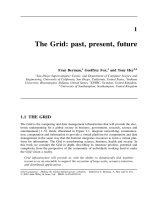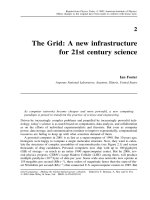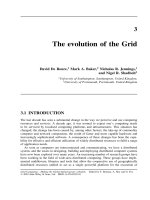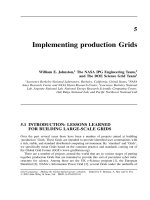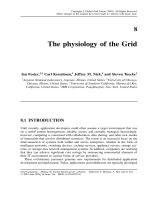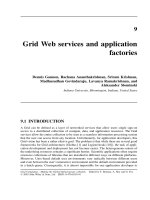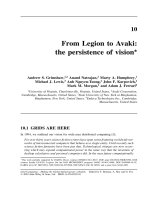Grid Computing P3
Bạn đang xem bản rút gọn của tài liệu. Xem và tải ngay bản đầy đủ của tài liệu tại đây (227.03 KB, 36 trang )
3
The evolution of the Grid
David De Roure,
1
Mark A. Baker,
2
Nicholas R. Jennings,
1
and Nigel R. Shadbolt
1
1
University of Southampton, Southampton, United Kingdom,
2
University of Portsmouth, Portsmouth, United Kingdom
3.1 INTRODUCTION
The last decade has seen a substantial change in the way we perceive and use computing
resources and services. A decade ago, it was normal to expect one’s computing needs
to be serviced by localised computing platforms and infrastructures. This situation has
changed; the change has been caused by, among other factors, the take-up of commodity
computer and network components, the result of faster and more capable hardware and
increasingly sophisticated software. A consequence of these changes has been the capa-
bility for effective and efficient utilization of widely distributed resources to fulfil a range
of application needs.
As soon as computers are interconnected and communicating, we have a distributed
system, and the issues in designing, building and deploying distributed computer systems
have now been explored over many years. An increasing number of research groups have
been working in the field of wide-area distributed computing. These groups have imple-
mented middleware, libraries and tools that allow the cooperative use of geographically
distributed resources unified to act as a single powerful platform for the execution of
Grid Computing – Making the Global Infrastructure a Reality. Edited by F. Berman, A. Hey and G. Fox
2003 John Wiley & Sons, Ltd ISBN: 0-470-85319-0
66
DAVID DE ROURE ET AL.
a range of parallel and distributed applications. This approach to computing has been
known by several names, such as metacomputing, scalable computing, global computing,
Internet computing and lately as Grid computing.
More recently there has been a shift in emphasis. In Reference [1], the ‘Grid problem’
is defined as ‘Flexible, secure, coordinated resource sharing among dynamic collections
of individuals, institutions, and resources’. This view emphasizes the importance of infor-
mation aspects, essential for resource discovery and interoperability. Current Grid projects
are beginning to take this further, from information to knowledge. These aspects of the
Grid are related to the evolution of Web technologies and standards, such as XML to
support machine-to-machine communication and the Resource Description Framework
(RDF) to represent interchangeable metadata.
The next three sections identify three stages of Grid evolution: first-generation systems
that were the forerunners of Grid computing as we recognise it today; second-generation
systems with a focus on middleware to support large-scale data and computation; and
current third-generation systems in which the emphasis shifts to distributed global collabo-
ration, a service-oriented approach and information layer issues. Of course, the evolution is
a continuous process and distinctions are not always clear-cut, but characterising the evo-
lution helps identify issues and suggests the beginnings of a Grid roadmap. In Section 3.5
we draw parallels with the evolution of the World Wide Web and introduce the notion of
the ‘Semantic Grid’ in which semantic Web technologies provide the infrastructure for
Grid applications. A research agenda for future evolution is discussed in a companion
paper (see Chapter 17).
3.2 THE EVOLUTION OF THE GRID: THE FIRST
GENERATION
The early Grid efforts started as projects to link supercomputing sites; at this time this
approach was known as metacomputing. The origin of the term is believed to have been
the CASA project, one of several US Gigabit test beds deployed around 1989. Larry
Smarr, the former NCSA Director, is generally accredited with popularising the term
thereafter [2].
The early to mid 1990s mark the emergence of the early metacomputing or Grid envi-
ronments. Typically, the objective of these early metacomputing projects was to provide
computational resources to a range of high-performance applications. Two representative
projects in the vanguard of this type of technology were FAFNER [3] and I-WAY [4].
These projects differ in many ways, but both had to overcome a number of similar hurdles,
including communications, resource management, and the manipulation of remote data,
to be able to work efficiently and effectively. The two projects also attempted to pro-
vide metacomputing resources from opposite ends of the computing spectrum. Whereas
FAFNER was capable of running on any workstation with more than 4 Mb of memory,
I-WAY was a means of unifying the resources of large US supercomputing centres.
3.2.1 FAFNER
The Rivest, Shamri and Adelman (RSA) public key encryption algorithm, invented by
Rivest, Shamri and Adelman at MIT’s Laboratory for Computer Science in 1976–1977
THE EVOLUTION OF THE GRID
67
[5], is widely used; for example, in the Secure Sockets Layer (SSL). The security of
RSA is based on the premise that it is very difficult to factor extremely large numbers,
in particular, those with hundreds of digits. To keep abreast of the state of the art in
factoring, RSA Data Security Inc. initiated the RSA Factoring Challenge in March 1991.
The Factoring Challenge provides a test bed for factoring implementations and provides
one of the largest collections of factoring results from many different experts worldwide.
Factoring is computationally very expensive. For this reason, parallel factoring algo-
rithms have been developed so that factoring can be distributed. The algorithms used
are trivially parallel and require no communications after the initial set-up. With this
set-up, it is possible that many contributors can provide a small part of a larger factor-
ing effort. Early efforts relied on electronic mail to distribute and receive factoring code
and information. In 1995, a consortium led by Bellcore Labs., Syracuse University and
Co-Operating Systems started a project, factoring via the Web, known as Factoring via
Network-Enabled Recursion (FAFNER).
FAFNER was set up to factor RSA130 using a new numerical technique called the
Number Field Sieve (NFS) factoring method using computational Web servers. The con-
sortium produced a Web interface to NFS. A contributor then used a Web form to invoke
server side Common Gateway Interface (CGI) scripts written in Perl. Contributors could,
from one set of Web pages, access a wide range of support services for the sieving
step of the factorisation: NFS software distribution, project documentation, anonymous
user registration, dissemination of sieving tasks, collection of relations, relation archival
services and real-time sieving status reports. The CGI scripts produced supported clus-
ter management, directing individual sieving workstations through appropriate day/night
sleep cycles to minimize the impact on their owners. Contributors downloaded and built a
sieving software daemon. This then became their Web client that used HTTP protocol to
GET values from and POST the resulting results back to a CGI script on the Web server.
Three factors combined to make this approach successful:
•
The NFS implementation allowed even workstations with 4 Mb of memory to perform
useful work using small bounds and a small sieve.
•
FAFNER supported anonymous registration; users could contribute their hardware
resources to the sieving effort without revealing their identity to anyone other than
the local server administrator.
•
A consortium of sites was recruited to run the CGI script package locally, forming a
hierarchical network of RSA130 Web servers, which reduced the potential administra-
tion bottleneck and allowed sieving to proceed around the clock with minimal human
intervention.
The FAFNER project won an award in TeraFlop challenge at Supercomputing 95 (SC95)
in San Diego. It paved the way for a wave of Web-based metacomputing projects.
3.2.2 I-WAY
The information wide area year (I-WAY) was an experimental high-performance net-
work linking many high-performance computers and advanced visualization environments
68
DAVID DE ROURE ET AL.
(CAVE). The I-WAY project was conceived in early 1995 with the idea not to build a
network but to integrate existing high bandwidth networks. The virtual environments,
datasets, and computers used resided at 17 different US sites and were connected by
10 networks of varying bandwidths and protocols, using different routing and switching
technologies.
The network was based on Asynchronous Transfer Mode (ATM) technology, which
at the time was an emerging standard. This network provided the wide-area backbone
for various experimental activities at SC95, supporting both Transmission Control Proto-
col/Internet Protocol (TCP/IP) over ATM and direct ATM-oriented protocols.
To help standardize the I-WAY software interface and management, key sites installed
point-of-presence (I-POP) servers to act as gateways to I-WAY. The I-POP servers were
UNIX workstations configured uniformly and possessing a standard software environment
called I-Soft. I-Soft attempted to overcome issues concerning heterogeneity, scalability,
performance, and security. Each site participating in I-WAY ran an I-POP server. The
I-POP server mechanisms allowed uniform I-WAY authentication, resource reservation,
process creation, and communication functions. Each I-POP server was accessible via the
Internet and operated within its site’s firewall. It also had an ATM interface that allowed
monitoring and potential management of the site’s ATM switch.
The I-WAY project developed a resource scheduler known as the Computational
Resource Broker (CRB). The CRB consisted of user-to-CRB and CRB-to-local-scheduler
protocols. The actual CRB implementation was structured in terms of a single central
scheduler and multiple local scheduler daemons – one per I-POP server. The central
scheduler maintained queues of jobs and tables representing the state of local machines,
allocating jobs to machines and maintaining state information on the Andrew File System
(AFS) (a distributed file system that enables co-operating hosts to share resources across
both local area and wide-area networks, based on the ‘AFS’ originally developed at
Carnegie-Mellon University).
In I-POP, security was handled by using a telnet client modified to use Kerberos
authentication and encryption. In addition, the CRB acted as an authentication proxy,
performing subsequent authentication to I-WAY resources on a user’s behalf. With regard
to file systems, I-WAY used AFS to provide a shared repository for software and scheduler
information. An AFS cell was set up and made accessible from only I-POPs. To move
data between machines in which AFS was unavailable, a version of remote copy was
adapted for I-WAY.
To support user-level tools, a low-level communications library, Nexus [6], was adapted
to execute in the I-WAY environment. Nexus supported automatic configuration mecha-
nisms that enabled it to choose the appropriate configuration depending on the technology
being used, for example, communications via TCP/IP or AAL5 (the ATM adaptation layer
for framed traffic) when using the Internet or ATM. The MPICH library (a portable imple-
mentation of the Message Passing Interface (MPI) standard) and CAVEcomm (networking
for the CAVE virtual reality system) were also extended to use Nexus.
The I-WAY project was application driven and defined several types of applications:
•
Supercomputing,
•
Access to Remote Resources,
THE EVOLUTION OF THE GRID
69
•
Virtual Reality, and
•
Video, Web, GII-Windows.
The I-WAY project was successfully demonstrated at SC’95 in San Diego. The I-POP
servers were shown to simplify the configuration, usage and management of this type of
wide-area computational test bed. I-Soft was a success in terms that most applications ran,
most of the time. More importantly, the experiences and software developed as part of the
I-WAY project have been fed into the Globus project (which we discuss in Section 3.2.2).
3.2.3 A summary of early experiences
Both FAFNER and I-WAY attempted to produce metacomputing environments by integrat-
ing resources from opposite ends of the computing spectrum. FAFNER was a ubiquitous
system that worked on any platform with a Web server. Typically, its clients were low-end
computers, whereas I-WAY unified the resources at multiple supercomputing centres.
The two projects also differed in the types of applications that could utilise their
environments. FAFNER was tailored to a particular factoring application that was in
itself trivially parallel and was not dependent on a fast interconnect. I-WAY, on the other
hand, was designed to cope with a range of diverse high-performance applications that
typically needed a fast interconnect and powerful resources. Both projects, in their way,
lacked scalability. For example, FAFNER was dependent on a lot of human intervention to
distribute and collect sieving results, and I-WAY was limited by the design of components
that made up I-POP and I-Soft.
FAFNER lacked a number of features that would now be considered obvious. For
example, every client had to compile, link, and run a FAFNER daemon in order to con-
tribute to the factoring exercise. FAFNER was really a means of task-farming a large
number of fine-grain computations. Individual computational tasks were unable to com-
municate with one another or with their parent Web-server. Likewise, I-WAY embodied
a number of features that would today seem inappropriate. The installation of an I-POP
platform made it easier to set up I-WAY services in a uniform manner, but it meant that
each site needed to be specially set up to participate in I-WAY. In addition, the I-POP
platform and server created one, of many, single points of failure in the design of the
I-WAY. Even though this was not reported to be a problem, the failure of an I-POP would
mean that a site would drop out of the I-WAY environment.
Notwithstanding the aforementioned features, both FAFNER and I-WAY were highly
innovative and successful. Each project was in the vanguard of metacomputing and helped
pave the way for many of the succeeding second-generation Grid projects. FAFNER was
the forerunner of the likes of SETI@home [7] and Distributed.Net [8], and I-WAY for
Globus [9] and Legion [10].
3.3 THE EVOLUTION OF THE GRID: THE SECOND
GENERATION
The emphasis of the early efforts in Grid computing was in part driven by the need to link
a number of US national supercomputing centres. The I-WAY project (see Section 3.2.2)
70
DAVID DE ROURE ET AL.
successfully achieved this goal. Today the Grid infrastructure is capable of binding
together more than just a few specialised supercomputing centres. A number of key
enablers have helped make the Grid more ubiquitous, including the take-up of high band-
width network technologies and adoption of standards, allowing the Grid to be viewed
as a viable distributed infrastructure on a global scale that can support diverse applica-
tions requiring large-scale computation and data. This vision of the Grid was presented in
Reference [11] and we regard this as the second generation, typified by many of today’s
Grid applications.
There are three main issues that had to be confronted:
•
Heterogeneity: A Grid involves a multiplicity of resources that are heterogeneous in
nature and might span numerous administrative domains across a potentially global
expanse. As any cluster manager knows, their only truly homogeneous cluster is their
first one!
•
Scalability: A Grid might grow from few resources to millions. This raises the prob-
lem of potential performance degradation as the size of a Grid increases. Consequently,
applications that require a large number of geographically located resources must be
designed to be latency tolerant and exploit the locality of accessed resources. Further-
more, increasing scale also involves crossing an increasing number of organisational
boundaries, which emphasises heterogeneity and the need to address authentication and
trust issues. Larger scale applications may also result from the composition of other
applications, which increases the ‘intellectual complexity’ of systems.
•
Adaptability: In a Grid, a resource failure is the rule, not the exception. In fact, with
so many resources in a Grid, the probability of some resource failing is naturally high.
Resource managers or applications must tailor their behaviour dynamically so that they
can extract the maximum performance from the available resources and services.
Middleware is generally considered to be the layer of software sandwiched between the
operating system and applications, providing a variety of services required by an applica-
tion to function correctly. Recently, middleware has re-emerged as a means of integrating
software applications running in distributed heterogeneous environments. In a Grid, the
middleware is used to hide the heterogeneous nature and provide users and applica-
tions with a homogeneous and seamless environment by providing a set of standardised
interfaces to a variety of services.
Setting and using standards is also the key to tackling heterogeneity. Systems use
varying standards and system application programming interfaces (APIs), resulting in the
need for port services and applications to the plethora of computer systems used in a Grid
environment. As a general principle, agreed interchange formats help reduce complexity,
because
n
converters are needed to enable
n
components to interoperate via one standard,
as opposed to
n
2
converters for them to interoperate with each other.
In this section, we consider the second-generation requirements, followed by repre-
sentatives of the key second-generation Grid technologies: core technologies, distributed
object systems, Resource Brokers (RBs) and schedulers, complete integrated systems and
peer-to-peer systems.
THE EVOLUTION OF THE GRID
71
3.3.1 Requirements for the data and computation infrastructure
The data infrastructure can consist of all manner of networked resources ranging from
computers and mass storage devices to databases and special scientific instruments.
Additionally, there are computational resources, such as supercomputers and clusters.
Traditionally, it is the huge scale of the data and computation, which characterises Grid
applications.
The main design features required at the data and computational fabric of the Grid are
the following:
•
Administrative hierarchy: An administrative hierarchy is the way that each Grid envi-
ronment divides itself to cope with a potentially global extent. The administrative hier-
archy, for example, determines how administrative information flows through the Grid.
•
Communication services: The communication needs of applications using a Grid
environment are diverse, ranging from reliable point-to-point to unreliable multicast
communication. The communications infrastructure needs to support protocols that
are used for bulk-data transport, streaming data, group communications, and those
used by distributed objects. The network services used also provide the Grid with
important Quality of Service (QoS) parameters such as latency, bandwidth, reliability,
fault tolerance, and jitter control.
•
Information services: A Grid is a dynamic environment in which the location and type
of services available are constantly changing. A major goal is to make all resources
accessible to any process in the system, without regard to the relative location of the
resource user. It is necessary to provide mechanisms to enable a rich environment in
which information about the Grid is reliably and easily obtained by those services
requesting the information. The Grid information (registration and directory) services
provide the mechanisms for registering and obtaining information about the structure,
resources, services, status and nature of the environment.
•
Naming services: In a Grid, like in any other distributed system, names are used to
refer to a wide variety of objects such as computers, services or data. The naming
service provides a uniform namespace across the complete distributed environment.
Typical naming services are provided by the international X.500 naming scheme or by
the Domain Name System (DNS) used by the Internet.
•
Distributed file systems and caching: Distributed applications, more often than not,
require access to files distributed among many servers. A distributed file system is
therefore a key component in a distributed system. From an application’s point of view
it is important that a distributed file system can provide a uniform global namespace,
support a range of file I/O protocols, require little or no program modification, and
provide means that enable performance optimisations to be implemented (such as the
usage of caches).
•
Security and authorisation: Any distributed system involves all four aspects of secu-
rity: confidentiality, integrity, authentication and accountability. Security within a Grid
environment is a complex issue requiring diverse resources autonomously administered
to interact in a manner that does not impact the usability of the resources and that
does not introduce security holes/lapses in individual systems or the environments as a
whole. A security infrastructure is key to the success or failure of a Grid environment.
72
DAVID DE ROURE ET AL.
•
System status and fault tolerance: To provide a reliable and robust environment it
is important that a means of monitoring resources and applications is provided. To
accomplish this, tools that monitor resources and applications need to be deployed.
•
Resource management and scheduling: The management of processor time, memory,
network, storage, and other components in a Grid are clearly important. The overall
aim is the efficient and effective scheduling of the applications that need to utilise the
available resources in the distributed environment. From a user’s point of view, resource
management and scheduling should be transparent and their interaction with it should be
confined to application submission. It is important in a Grid that a resource management
and scheduling service can interact with those that may be installed locally.
•
User and administrative GUI : The interfaces to the services and resources avail-
able should be intuitive and easy to use as well as being heterogeneous in nature.
Typically, user and administrative access to Grid applications and services are Web-
based interfaces.
3.3.2 Second-generation core technologies
There are growing numbers of Grid-related projects, dealing with areas such as infras-
tructure, key services, collaborations, specific applications and domain portals. Here we
identify some of the most significant to date.
3.3.2.1 Globus
Globus [9] provides a software infrastructure that enables applications to handle dis-
tributed heterogeneous computing resources as a single virtual machine. The Globus
project is a US multi-institutional research effort that seeks to enable the construction of
computational Grids. A computational Grid, in this context, is a hardware and software
infrastructure that provides dependable, consistent, and pervasive access to high-end com-
putational capabilities, despite the geographical distribution of both resources and users.
A central element of the Globus system is the Globus Toolkit, which defines the basic
services and capabilities required to construct a computational Grid. The toolkit consists
of a set of components that implement basic services, such as security, resource location,
resource management, and communications.
It is necessary for computational Grids to support a wide variety of applications and
programming paradigms. Consequently, rather than providing a uniform programming
model, such as the object-oriented model, the Globus Toolkit provides a bag of services
that developers of specific tools or applications can use to meet their own particular needs.
This methodology is only possible when the services are distinct and have well-defined
interfaces (APIs) that can be incorporated into applications or tools in an incremen-
tal fashion.
Globus is constructed as a layered architecture in which high-level global services are
built upon essential low-level core local services. The Globus Toolkit is modular, and
an application can exploit Globus features, such as resource management or information
infrastructure, without using the Globus communication libraries. The Globus Toolkit
currently consists of the following (the precise set depends on the Globus version):
THE EVOLUTION OF THE GRID
73
•
An HTTP-based ‘Globus Toolkit resource allocation manager’ (GRAM) protocol is used
for allocation of computational resources and for monitoring and control of computation
on those resources.
•
An extended version of the file transfer protocol, GridFTP, is used for data access;
extensions include use of connectivity layer security protocols, partial file access, and
management of parallelism for high-speed transfers.
•
Authentication and related security services (GSI – Grid security infrastructure).
•
Distributed access to structure and state information that is based on the lightweight
directory access protocol (LDAP). This service is used to define a standard resource
information protocol and associated information model.
•
Remote access to data via sequential and parallel interfaces (GASS – global access to
secondary storage) including an interface to GridFTP.
•
The construction, caching and location of executables (GEM – Globus executable man-
agement).
•
Resource reservation and allocation (GARA – Globus advanced reservation and allo-
cation).
Globus has evolved from its original first-generation incarnation as I-WAY, through Ver-
sion 1 (GT1) to Version 2 (GT2). The protocols and services that Globus provided have
changed as it has evolved. The emphasis of Globus has moved away from supporting just
high-performance applications towards more pervasive services that can support virtual
organisations. The evolution of Globus is continuing with the introduction of the Open
Grid Services Architecture (OGSA) [12], a Grid architecture based on Web services and
Globus (see Section 3.4.1 for details).
3.3.2.2 Legion
Legion [10] is an object-based ‘metasystem’, developed at the University of Virginia.
Legion provided the software infrastructure so that a system of heterogeneous, geograph-
ically distributed, high-performance machines could interact seamlessly. Legion attempted
to provide users, at their workstations, with a single integrated infrastructure, regardless
of scale, physical location, language and underlying operating system.
Legion differed from Globus in its approach to providing to a Grid environment: it
encapsulated all its components as objects. This methodology has all the normal advan-
tages of an object-oriented approach, such as data abstraction, encapsulation, inheritance
and polymorphism.
Legion defined the APIs to a set of core objects that support the basic services needed
by the metasystem. The Legion system had the following set of core object types:
•
Classes and metaclasses: Classes can be considered as managers and policy makers.
Metaclasses are classes of classes.
•
Host objects: Host objects are abstractions of processing resources; they may represent
a single processor or multiple hosts and processors.
•
Vault objects: Vault objects represent persistent storage, but only for the purpose of
maintaining the state of object persistent representation.
74
DAVID DE ROURE ET AL.
•
Implementation objects and caches: Implementation objects hide details of storage
object implementations and can be thought of as equivalent to an executable in UNIX.
•
Binding agents: A binding agent maps object IDs to physical addressees.
•
Context objects and context spaces: Context objects map context names to Legion
object IDs, allowing users to name objects with arbitrary-length string names.
Legion was first released in November 1997. Since then the components that make
up Legion have continued to evolve. In August 1998, Applied Metacomputing was
established to exploit Legion commercially. In June 2001, Applied Metacomputing was
relaunched as Avaki Corporation [13].
3.3.3 Distributed object systems
The Common Object Request Broker Architecture (CORBA) is an open distributed
object-computing infrastructure being standardised by the Object Management Group
(OMG) [14]. CORBA automates many common network programming tasks such as
object registration, location, and activation; request de-multiplexing; framing and error-
handling; parameter marshalling and de-marshalling; and operation dispatching. Although
CORBA provides a rich set of services, it does not contain the Grid level allocation and
scheduling services found in Globus (see Section 3.2.1), however, it is possible to integrate
CORBA with the Grid.
The OMG has been quick to demonstrate the role of CORBA in the Grid infrastruc-
ture; for example, through the ‘Software Services Grid Workshop’ held in 2001. Apart
from providing a well-established set of technologies that can be applied to e-Science,
CORBA is also a candidate for a higher-level conceptual model. It is language-neutral and
targeted to provide benefits on the enterprise scale, and is closely associated with the Uni-
fied Modelling Language (UML). One of the concerns about CORBA is reflected by the
evidence of intranet rather than Internet deployment, indicating difficulty crossing organi-
sational boundaries; for example, operation through firewalls. Furthermore, real-time and
multimedia support were not part of the original design.
While CORBA provides a higher layer model and standards to deal with heterogeneity,
Java provides a single implementation framework for realising distributed object systems.
To a certain extent the Java Virtual Machine (JVM) with Java-based applications and
services are overcoming the problems associated with heterogeneous systems, provid-
ing portable programs and a distributed object model through remote method invocation
(RMI). Where legacy code needs to be integrated, it can be ‘wrapped’ by Java code.
However, the use of Java in itself has its drawbacks, the main one being computational
speed. This and other problems associated with Java (e.g. numerics and concurrency) are
being addressed by the likes of the Java Grande Forum (a ‘Grande Application’ is ‘any
application, scientific or industrial, that requires a large number of computing resources,
such as those found on the Internet, to solve one or more problems’) [15]. Java has also
been chosen for UNICORE (see Section 3.6.3). Thus, what is lost in computational speed
might be gained in terms of software development and maintenance times when taking a
broader view of the engineering of Grid applications.
THE EVOLUTION OF THE GRID
75
3.3.3.1 Jini and RMI
Jini [16] is designed to provide a software infrastructure that can form a distributed
computing environment that offers network plug and play. A collection of Jini-enabled
processes constitutes a Jini community – a collection of clients and services all commu-
nicating by the Jini protocols. In Jini, applications will normally be written in Java and
communicated using the Java RMI mechanism. Even though Jini is written in pure Java,
neither Jini clients nor services are constrained to be pure Java. They may include Java
wrappers around non-Java code, or even be written in some other language altogether.
This enables a Jini community to extend beyond the normal Java framework and link
services and clients from a variety of sources.
More fundamentally, Jini is primarily concerned with communications between devices
(not what devices do). The abstraction is the service and an interface that defines a service.
The actual implementation of the service can be in hardware, software, or both. Services in
a Jini community are mutually aware and the size of a community is generally considered
that of a workgroup. A community’s lookup service (LUS) can be exported to other
communities, thus providing interaction between two or more isolated communities.
In Jini, a device or software service can be connected to a network and can announce
its presence. Clients that wish to use such a service can then locate it and call it to perform
tasks. Jini is built on RMI, which introduces some constraints. Furthermore, Jini is not a
distributed operating system, as an operating system provides services such as file access,
processor scheduling and user logins. The five key concepts of Jini are
•
Lookup: to search for a service and to download the code needed to access it,
•
Discovery: to spontaneously find a community and join,
•
Leasing: time-bounded access to a service,
•
Remote events: service A notifies service B of A’s state change. Lookup can notify all
services of a new service, and
•
Transactions: used to ensure that a system’s distributed state stays consistent.
3.3.3.2 The common component architecture forum
The Common Component Architecture Forum [17] is attempting to define a minimal set of
standard features that a high-performance component framework would need to provide,
or can expect, in order to be able to use components developed within different frame-
works. Like CORBA, it supports component programming, but it is distinguished from
other component programming approaches by the emphasis on supporting the abstrac-
tions necessary for high-performance programming. The core technologies described in
the previous section, Globus or Legion, could be used to implement services within a
component framework.
The idea of using component frameworks to deal with the complexity of developing
interdisciplinary high-performance computing (HPC) applications is becoming increas-
ingly popular. Such systems enable programmers to accelerate project development by
introducing higher-level abstractions and allowing code reusability. They also provide
clearly defined component interfaces, which facilitate the task of team interaction; such a
standard will promote interoperability between components developed by different teams
76
DAVID DE ROURE ET AL.
across different institutions. These potential benefits have encouraged research groups
within a number of laboratories and universities to develop and experiment with prototype
systems. There is a need for interoperability standards to avoid fragmentation.
3.3.4 Grid resource brokers and schedulers
3.3.4.1 Batch and scheduling systems
There are several systems available whose primary focus is batching and resource schedul-
ing. It should be noted that all the packages listed here started life as systems for managing
jobs or tasks on locally distributed computing platforms. A fuller list of the available
software can be found elsewhere [18, 19].
•
Condor [20] is a software package for executing batch jobs on a variety of UNIX
platforms, in particular, those that would otherwise be idle. The major features of
Condor are automatic resource location and job allocation, check pointing, and the
migration of processes. These features are implemented without modification to the
underlying UNIX kernel. However, it is necessary for a user to link their source code
with Condor libraries. Condor monitors the activity on all the participating computing
resources; those machines that are determined to be available are placed in a resource
pool. Machines are then allocated from the pool for the execution of jobs. The pool
is a dynamic entity – workstations enter when they become idle and leave when they
get busy.
•
The portable batch system (PBS) [21] is a batch queuing and workload management
system (originally developed for NASA). It operates on a variety of UNIX platforms,
from clusters to supercomputers. The PBS job scheduler allows sites to establish their
own scheduling policies for running jobs in both time and space. PBS is adaptable
to a wide variety of administrative policies and provides an extensible authentication
and security model. PBS provides a GUI for job submission, tracking, and administra-
tive purposes.
•
The sun Grid engine (SGE) [22] is based on the software developed by Genias known as
Codine/GRM. In the SGE, jobs wait in a holding area and queues located on servers pro-
vide the services for jobs. A user submits a job to the SGE, and declares a requirements
profile for the job. When a queue is ready for a new job, the SGE determines suitable
jobs for that queue and then dispatches the job with the highest priority or longest
waiting time; it will try to start new jobs on the most suitable or least loaded queue.
•
The load sharing facility (LSF) is a commercial system from Platform Computing
Corp. [23]. LSF evolved from the Utopia system developed at the University of Toronto
[24] and is currently the most widely used commercial job management system. LSF
comprises distributed load sharing and batch queuing software that manages, monitors
and analyses the resources and workloads on a network of heterogeneous computers,
and has fault-tolerance capabilities.
3.3.4.2 Storage resource broker
The Storage Resource Broker (SRB) [25] has been developed at San Diego Supercomputer
Centre (SDSC) to provide ‘uniform access to distributed storage’ across a range of storage
THE EVOLUTION OF THE GRID
77
devices via a well-defined API. The SRB supports file replication, and this can occur either
off-line or on the fly. Interaction with the SRB is via a GUI. The SRB servers can be
federated. The SRB is managed by an administrator, with authority to create user groups.
A key feature of the SRB is that it supports metadata associated with a distributed file
system, such as location, size and creation date information. It also supports the notion of
application-level (or domain-dependent) metadata, specific to the content, which cannot
be generalised across all data sets. In contrast with traditional network file systems, SRB
is attractive for Grid applications in that it deals with large volumes of data, which can
transcend individual storage devices, because it deals with metadata and takes advantage
of file replication.
3.3.4.3 Nimrod/G resource broker and GRACE
Nimrod-G is a Grid broker that performs resource management and scheduling of param-
eter sweep and task-farming applications [26, 27]. It consists of four components:
•
A task-farming engine,
•
A scheduler,
•
A dispatcher, and
•
Resource agents.
A Nimrod-G task-farming engine allows user-defined schedulers, customised applications
or problem-solving environments (e.g. ActiveSheets [28]) to be ‘plugged in’, in place of
default components. The dispatcher uses Globus for deploying Nimrod-G agents on remote
resources in order to manage the execution of assigned jobs. The Nimrod-G scheduler
has the ability to lease Grid resources and services depending on their capability, cost,
and availability. The scheduler supports resource discovery, selection, scheduling, and the
execution of user jobs on remote resources. The users can set the deadline by which time
their results are needed and the Nimrod-G broker tries to find the best resources available
in the Grid, uses them to meet the user’s deadline and attempts to minimize the costs of
the execution of the task.
Nimrod-G supports user-defined deadline and budget constraints for scheduling optimi-
sations and manages the supply and demand of resources in the Grid using a set of resource
trading services called Grid Architecture for Computational Economy (GRACE) [29].
There are four scheduling algorithms in Nimrod-G [28]:
•
Cost optimisation uses the cheapest resources to ensure that the deadline can be met
and that computational cost is minimized.
•
Time optimisation uses all the affordable resources to process jobs in parallel as early
as possible.
•
Cost-time optimisation is similar to cost optimisation, but if there are multiple resources
with the same cost, it applies time optimisation strategy while scheduling jobs on them.
•
The conservative time strategy is similar to time optimisation, but it guarantees that
each unprocessed job has a minimum budget-per-job.
The Nimrod-G broker with these scheduling strategies has been used in solving large-
scale data-intensive computing applications such as the simulation of ionisation chamber
calibration [27] and the molecular modelling for drug design [30].
78
DAVID DE ROURE ET AL.
3.3.5 Grid portals
A Web portal allows application scientists and researchers to access resources specific to
a particular domain of interest via a Web interface. Unlike typical Web subject portals, a
Grid portal may also provide access to Grid resources. For example, a Grid portal may
authenticate users, permit them to access remote resources, help them make decisions
about scheduling jobs, and allow users to access and manipulate resource information
obtained and stored on a remote database. Grid portal access can also be personalised by
the use of profiles, which are created and stored for each portal user. These attributes,
and others, make Grid portals the appropriate means for Grid application users to access
Grid resources.
3.3.5.1 The NPACI HotPage
The NPACI HotPage [31] is a user portal that has been designed to be a single point-of-
access to computer-based resources, to simplify access to resources that are distributed
across member organisations and allows them to be viewed either as an integrated Grid
system or as individual machines.
The two key services provided by the HotPage are information and resource access and
management services. The information services are designed to increase the effectiveness
of users. It provides links to
•
user documentation and navigation,
•
news items of current interest,
•
training and consulting information,
•
data on platforms and software applications, and
•
Information resources, such as user allocations and accounts.
The above are characteristic of Web portals. HotPage’s interactive Web-based service also
offers secure transactions for accessing resources and allows the user to perform tasks such
as command execution, compilation, and running programs. Another key service offered
by HotPage is that it provides status of resources and supports an easy mechanism for
submitting jobs to resources. The status information includes
•
CPU load/percent usage,
•
processor node maps,
•
queue usage summaries, and
•
current queue information for all participating platforms.
3.3.5.2 The SDSC Grid port toolkit
The SDSC Grid port toolkit [32] is a reusable portal toolkit that uses HotPage infras-
tructure. The two key components of GridPort are the Web portal services and the
application APIs. The Web portal module runs on a Web server and provides secure
(authenticated) connectivity to the Grid. The application APIs provide a Web interface
that helps end users develop customised portals (without having to know the underlying
